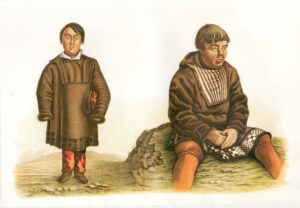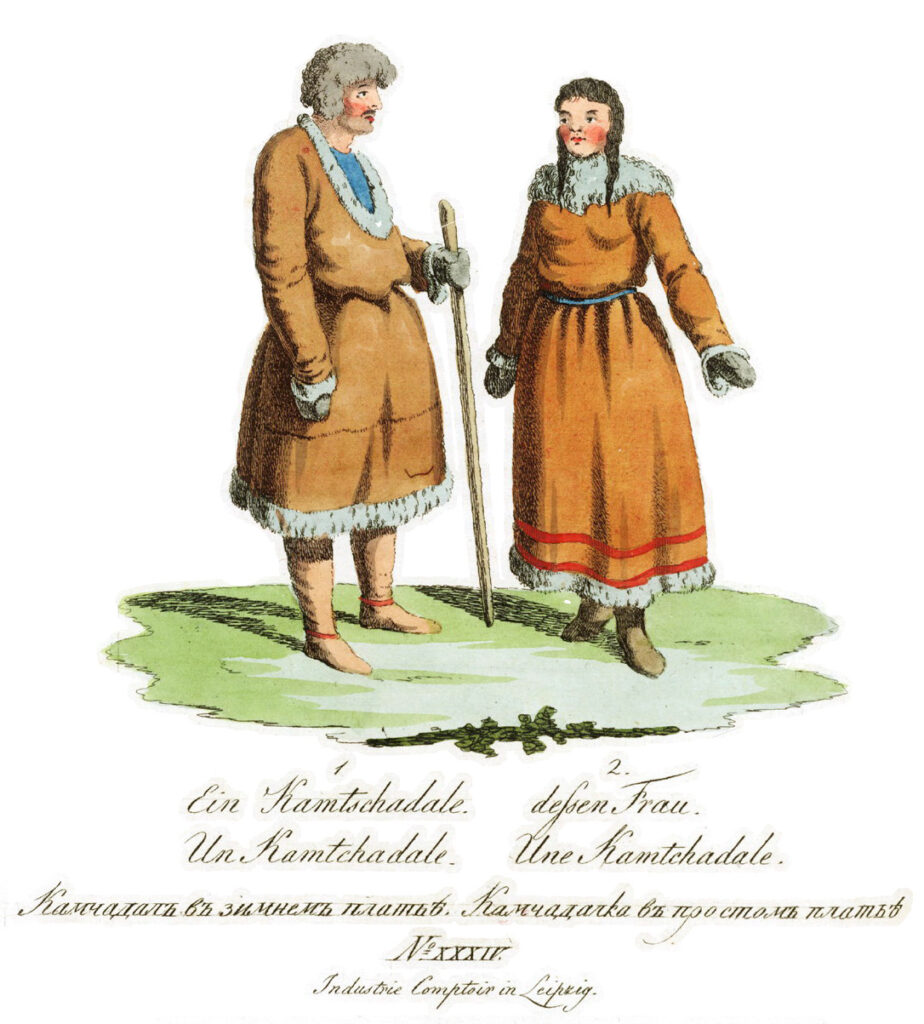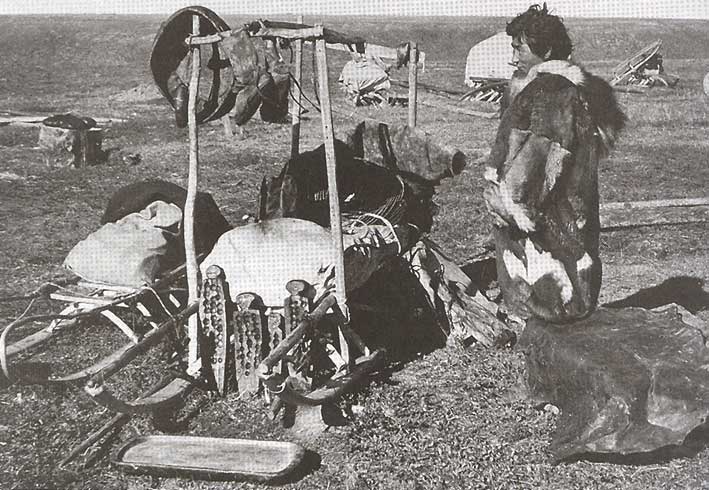
An ethnonym камчадалы, по первым письменным источникам, описывающим коренное население Камчатки (С.П. Крашенинников, Г.В. Стеллер), относится к ительменам и возводится к корякскому кончала. Камчадалами были названы «сидячие иноземцы» двух селений севернее Тигиля и 3 севернее Уки. После 1800 года это название переносится на жителей двух последних курильских селений. До конца ХIХ в. в официальных документах учета населения потомки оседлых аборигенов называются камчадалами, потомки русских старожилов – русскими. Исследователи конца ХIХ в. (В.Г. Богораз, В.Н. Тюшов, Н.В. Слюнин) отмечали, что оседлые коряки сами себя именуют камчадалами, объясняя это тем, что так их называет «начальство». С нач. ХIХ в. этноним камчадалы распространился также на русское население Камчатки, обнаруживающее сходство во внешнем облике, образе жизни и языке с аборигенным. К 1920 году камчадалами называли обрусевшее аборигенное оседлое население и смешавшихся с ним потомков русских старожилов. По данным Всесоюзной переписи 1926 года, в Камчатском округе числилось 3704 камчадалов В их число также входила группа ительменов, впоследствии выделенная особо.
В 1932 году ареал камчадалов был разделен административной границей между Камчатской обл. и Корякским а.о. Часть тигильских камчадалов под названием ительменов получила официальный статус «коренной народности», другая часть, оказавшаяся за пределами национального образования, вскоре лишилась своего самоназвания и статуса особой этнической группы. В материалах переписи 1939 года из официального перечня этноним камчадалы исчез. В регионе существовала также группа пенжинских русских, или пенжинцев (в 1897 оду – 210 чел). Это были русско-корякские метисы, воспринявшие образ жизни пенжинских оседлых коряков. В переписи 1926 года они зафиксированы как русские, но начиная с 1950-х гг. стали именовать себя камчадалы, чтобы подчеркнуть свое отличие от русских новейшей миграционной волны. Большинство из них проживает в с. Манилы и Каменское.

В настоящее время потомки камчадалов, связанные с традиционным хозяйством, живут в Соболевском, Большерецком, Мильковском, Ключевском и Усть-Камчатском р-нах Камчатской обл. и Тигильском и Пенжинском р-нах Корякского а.о. Их численность ориентировочно 8–10 тыс. чел. Кроме того, в г. Петропавловске-Камчатском и Елизовском р-не себя считают камчадалами еще несколько тысяч человек, в большинстве своем потомков двух последних русских дореволюционных волн переселения – 1850 г. и 1912–1914 гг. Они также преимущественно заняты рыболовством. Установление генеалогической принадлежности современного камчадала к коренному и старожильческому населению Камчатки нуждается в исследовании. Начиная с 1989 года потомки камчадалов обращаются в органы законодательной власти с требованием о возвращении камчадалам статуса этнической группы коренного населения Камчатки.
Группа метисного населения Камчатки начала складываться в сер. ХVIII в. и росла по мере увеличения русского населения полуострова. К нач. ХIХ в. на Камчатке существовало 5 русских острогов и 2 крестьянские деревни, а численность русских составляла более 1,5 тыс. чел. Женщины, как правило, были аборигенного и метисного происхождения.
Русское население расселилось на полуострове неравномерно. В 1740-е гг. оно концентрировалось в основном на западном побережье, в Большерецком остроге. В нач. ХIХ в. на западном побережье в двух русских поселениях Тигиль и Большерецк проживало соответственно 185 и 69 русских, аборигенного населения – ок. 1,2 тыс. чел. В долине р. Камчатки в 4 русских поселениях было 660 русских и 612 аборигенов. На восточном побережье и вокруг Петропавловска поселений аборигенов не осталось. В Петропавловске и окружающих его острогах жили 537 русских. Различное соотношение пришлого и аборигенного населения в отдельных ареалах оказывало влияние на ассимиляционные и метисационные процессы. Русские колонисты Камчатки, сначала казаки, затем крестьяне, привезенные на полуостров для развития хлебопашества, промышленные люди, занимавшиеся пушным промыслом, торговые люди и духовенство оказались в относительной изоляции от остального русского мира. Русские женились на ительменках, выходили замуж за ясачных камчадалов, и их дети причислялись к ясачному сословию.
Русские переселенцы перенимали у аборигенов систему хозяйства и образ жизни. Несмотря на то что с 1740-х гг. на Камчатку присылались партии сибирских крестьян с Лены, Илима, уже адаптировавших культуру хлебопашества к суровым сибирским условиям (колониальная администрация рассчитывала обеспечить Камчатку собственным хлебом), вновь прибывшие крестьяне скоро бросали хлебопашество и переходили к рыболовству и охоте. За рыболовством по значимости следовали собирательство и огородничество. В летнее время население находилось в местах рыбного лова, и огороды не поливались, поэтому урожаи были невысоки. В ХVIII – 1-й трети ХХ в. на Камчатке распространились якутские породы коров и лошадей, хорошо приспособленные к морозам и скудному зимнему рациону. Для коров запасали небольшое количество сена на зиму, лошади зимой добывали себе корм сами, выпасаясь в лесах. Для содержания коров строили навес, стенами в зимнее время служили сугробы снега. Лошади летом содержались на привязи. Как аборигены, так и русские колонисты практиковали осеннюю охоту на дикого оленя и горного барана с применением верховых лошадей. Пушная охота и промысел морского зверя носили подсобный характер. Основным видом сухопутного транспорта служили собачьи упряжки. В кон. ХIХ в. каждое хозяйство камчадалов имело в среднем 13–15 собак, 1 лошадь и 2 коровы.
Культурно-историческое единство метисного населения Камчатки выражалось в обоюдном двуязычии: и русские, и аборигены владели камчадальским (ительменским) и русским языками. Оно сложилось на полуострове во 2-й пол. ХVIII в. благодаря появлению сети церковноприходских школ и совместному обучению детей аборигенов и русских. В 1749 году здесь существовало 10 школ, в которыхрых обучалось более 200 детей. Первыми учителями были выпускники Московской славяно-греко-латинской академии. Эпоха просвещения на Камчатке закончилась с началом эпидемий и голодовок (1769 г.). В 1783 году на Камчатке не осталось ни одной школы, к 1834 существовало 1 духовное уч-ще с 13 учащимися и ремесленная школа с 8 учениками. В этот период возникло «камчатское наречие» рус. яз. Оно, как и двустороннее двуязычие, сохранялось у старшего поколения камчадалов до последнего времени.
ИсточникːСеверная энциклопедия. – М.:Европейские издания, 2004. Составитель: Е.Р. Акбальян




